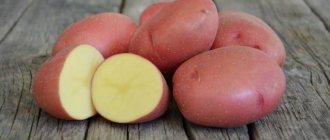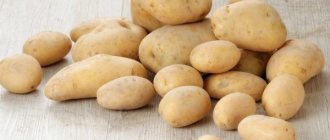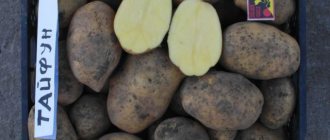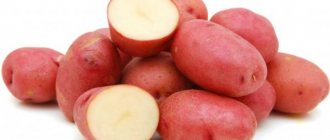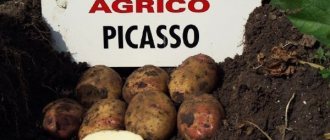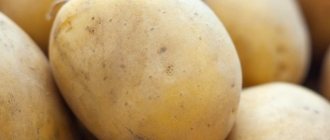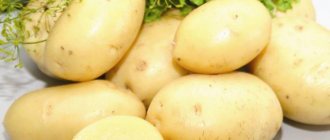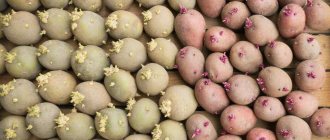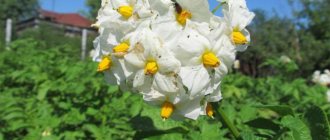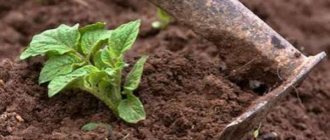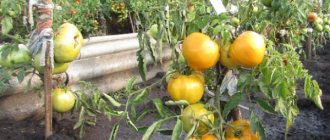German breeders have created many varieties of potatoes. Among them is the highly productive and promising variety Natasha. It was obtained at the beginning of the 21st century. The new vegetable was liked by European gardeners.
Vegetable growers in Russia also grow this variety of potatoes. At first it was bred in private plots. High early harvests attracted the attention of large agricultural producers.
Comment! Natasha potatoes are officially recognized by the State Register of the Russian Federation for the Middle Volga region.
Description
Potato bushes of the Natasha variety are not too tall, semi-erect, of intermediate type. The leaves are large, with noticeable waviness. The tops are light or dark green. The flowers are whitish, with a barely noticeable blue against the background of bright yellow pistils.
Tubers of varietal potatoes are medium-sized, oval, smooth, even. Clumsiness practically does not occur. The color of the peel is light yellow, with almost invisible eyes. On average, one potato weighs 96-133 grams. When cut, the flesh is dark yellow. The value of the Natasha variety in large quantities of starch is 11.2-13.6%.
The tuber itself, leaves, and flowers are clearly visible in the photo.
Attention! Vegetable growers in Europe and Russia value German-bred potatoes for their high and stable yield and excellent commercial qualities.
Productivity
High yield rates are genetically inherent in this variety. Commercial yields remain at the level of 130 - 190 centners per hectare, which is 30 - 40 centners higher than the standard Udacha and Rozara varieties for the region. The maximum yield was collected within 320 c/ha, which is 80 c/ha higher than the standard.
The yield of any potato is directly related to soil fertility. It would be naive to believe that if a variety is genetically programmed for productivity, it can bear fruit abundantly on poor soils.
Potato is a crop that produces a high removal of nutrients from the soil. And in order for it to show its productivity, it is necessary to have a high nutritional value of the land.
Experienced vegetable growers apply organic fertilizers to potatoes annually. This is the only way to increase fertility, provide the crop with nutrients and mineral elements, and humus compounds will balance all substances and make them available for consumption by the crop.
If there is no access to organic matter, vegetable growers use mineral fertilizers, which lead not to fertility, but to mineralization of the soil. An alternative to good organic fertilizers, humus of animal origin, is compost. Every gardener can prepare it by simply building a compost bin on his or her own plot. But the benefits from compost will be much greater than from mineral “sprinkling”.
May be interesting How to hill potatoes with a walk-behind tractor and cultivator: useful tips The best varieties of cucumbers for the Rostov region Secret technologies for growing potatoes
Advantages of the variety
Potatoes are just beginning to win the love of Russians due to their characteristics. Let's look at them in more detail:
- Potatoes Natasha are early ripening. The tubers are ready within 2.5 months after planting.
- More than a dozen tubers ripen in one nest of the Natasha variety. You can collect from 132 to 191 centners of early potatoes from one hectare. Look at the photo taken by gardeners. Here is a harvest from two bushes of the Natasha variety.
- Good yield even in dry years.
- When transporting potatoes, there is practically no mechanical damage.
- The Natasha variety, judging by the reviews of gardeners who have tried the selection potatoes, is undemanding to the soil and grows well in any garden.
- Varietal potatoes are characterized by high keeping quality. When favorable conditions are created, the safety of the harvest reaches 93%. The commercial qualities of the vegetable are not lost during the winter period.
- Potato variety Natasha is resistant to many potato diseases.
- The table variety has excellent taste and culinary characteristics. Due to the high starch content it turns out crumbly. For potato salad lovers, there is no better vegetable.
Important! When boiling and frying, Natasha variety potatoes do not lose their shape or become soft.
Advantages of the Natasha potato variety
Gardeners have long noticed that this variety is characterized by good keeping quality and resistance to mechanical damage. Thanks to this, it is grown not only at home, but also in the fields for subsequent sale.
When growing potatoes, it is important to pay attention not only to the timing of ripening, but also to the yield. In this case, you will be able to rationally use the area of your summer cottage and get the maximum yield from one bush. Good presentation is an important characteristic for those wishing to grow potatoes for sale. The Natasha variety will delight you with beautiful and smooth tubers and will retain its original properties throughout the entire storage period.
Diseases and pests
German breeders have done their best: tubers and tops practically do not suffer from:
- golden potato cyst nematode;
- potato cancer;
- tuberous rot;
- rhizoctonia;
- Y-virus.
But this does not mean that after planting potatoes, you can ignore them. You should inspect the tops from time to time.
Advice! If you detect the slightest signs of disease or pest damage, you need to resort to treatment with special means.
The main advantages and disadvantages of Natasha potatoes
Gardeners find many positive qualities in Natasha potatoes, but there are also several negative aspects.
| pros | Minuses |
| Precocity | Tendency to be affected by Colorado potato beetles |
| Resistant to drought, frost, disease and bugs | |
| Undemanding to soil | |
| High shelf life, crop safety 93% | |
| Presentable presentation of fruits | |
| Excellent taste, universal use in cooking |
Features of preparatory work
Since the Natasha variety is an early ripening variety, when choosing planting dates you need to focus on the temperature regime and the readiness of the soil.
Seed preparation
Potatoes the size of a chicken egg or a little larger are placed on the seeds. Must be stored separately from main supplies. Seed potatoes of the Natasha variety must be removed from the cellar at least 30 days before planting. This is a necessary measure: the seeds need time to warm up, the eyes need to wake up and hatch.
Germination of Natasha varietal potatoes should be carried out in a warm room with good lighting. It’s not bad if the tubers receive direct sunlight.
Warning! After removing the seed potatoes from storage, inspect each tuber. At the slightest defect, remove from the planting stock.
When the eyes hatch, the planting material of the Natasha variety is treated with Prestige and Heteroauxin.
Soil preparation
The soil is usually prepared in the fall after harvesting. Even small weeds are removed first. Fertilizers are applied, preferably humus or compost. In the spring, the garden is dug up and the surface is leveled.
Rules for planting potatoes
When planting large areas, use a cultivator or potato planter. If the area for potatoes is small, then the work is done manually; holes are prepared using a bayonet shovel.
In each hole you need to add at least five tablespoons of stove ash and 700 grams of well-rotted manure. There is no need to bury the tubers of the Natasha variety, so as not to create inconvenience when digging. Do not forget that when hilling, a ridge will still appear on top.
Planting is carried out in rows, the step between them is at least 0.7 m. The distance between the Natasha variety potatoes in a row is about 35 cm. This gap provides sufficient lighting and warming of the soil, the bushes are easy to weed and hill up. Each family member finds something to do when planting potatoes, as in this photo.
After the planting work is completed, the garden is leveled with a rake. This is necessary to remove the crust on the surface of the earth (even with careful work, the soil is still trampled down) and to destroy the root system of emerging weed buds.
Attention! The first shoots of Natasha varietal potatoes, as a rule, appear within 10 days with sufficient soil moisture and comfortable air temperature.
Growing
To obtain the declared high yield, the variety requires attention and regular care. It is obligatory to carry out timely loosening of the soil, and, if necessary, watering, hilling bushes, and fighting Colorado potato beetles and other pests. The variety can grow on any type of cultivated soil.
Planting material
Natasha seed potato tubers selected for planting in the fall are taken out of the basement one and a half to two months before the start of spring work.
- The tubers are sorted. Those with signs of disease are rejected and placed in boxes for germination.
- Medium-sized tubers are selected for planting.
- For better germination, it is advisable to place them in boxes in two or three layers, no more.
- Potato variety Natasha is grown in rooms where there is enough sunlight. In good light, the sprouts on the tubers do not stretch out, but gradually rise up stocky and strong, and the rudiments of roots and leaves are visible on them.
- First, for a week or 10 days, in the room with the germinating tubers, you need to maintain a temperature of at least 18-200C. During this time, sleeping eyes awaken.
- When rapid growth of shoots begins, the temperature is reduced to 10-140C so that the shoots do not stretch.
Start planting tubers when the ground temperature is above 70C.
Important! Tubers for planting are germinated in the light also because solanine is formed in them under such conditions. Thanks to this substance, the plant's immunity increases.
Soil preparation
The soil in the area where Natasha potatoes will grow needs to be prepared in the fall.
- The area is cleared of weeds and plowed.
- Before plowing, manure or humus is spread at the rate of 5-7 kg per 1 m2.
- 15-20 g of potassium sulfate and 35-40 g of superphosphate per m2 are also sprinkled on the ground.
- Instead of applying organic matter and mineral fertilizers, sometimes the area where Natasha potatoes will grow is sown with green manure after plowing: rye or mustard. If the rye grows vigorously, it can be cut off in late autumn, leaving the greens on the ground. The mustard is not removed.
- In the spring the area is cultivated again.
Landing
On the day of planting, boxes with tubers are taken out to the site and the tubers are treated with growth stimulants, as well as with the pest control drug “Prestige”.
- The crop is planted in rows with a distance of at least 70 cm, with 30 cm between holes. This planting method will provide enough nutrients to each bush and make it easier to care for the crop.
- The holes are fertilized by pouring out a 0.5 or 0.7 g jar of dry humus and a handful (5 tablespoons) of wood ash.
- The tubers are carefully laid out in holes or furrows to a depth of 10 cm with the sprouts facing upward and sprinkled with soil.
- The rows are leveled using a rake.
Advice! Instead of organic matter, use mineral products to fertilize the holes: 1 tablespoon of nitrophoska and half a glass of bone meal or ready-made complex preparations in accordance with the instructions.
How to properly care
Potato Natasha, judging by the description, characteristics of the variety, photos and reviews of vegetable growers, steadily tolerates unfavorable climate during the period of vegetative development. When using agricultural techniques, you can create a rich harvest.
Necessary actions:
- Weeds grow faster than potatoes. Until the first shoots appear, the garden needs to be harrowed several times. This can be done using a rake with large sharp teeth or a harrow. Two problems are immediately solved: thin strings of weeds are removed, which immediately dry out in the sun, and the crust is removed from the surface of the soil. The access of oxygen to the roots of the plant increases.
- If there is a threat of frost returning, the emerging seedlings need to be “wrapped up” during the first hilling. In addition to preserving moisture inside the bush, such hilling does not allow weeds to live freely. You need to raise the soil above the bush twice to increase the number of stolons and the formation of more tubers.
- If the soil was well fertilized in the fall and fertilizing was applied when planting the tubers, then for potatoes of the Natasha variety, root fertilizing during the growing season is not necessary.
- As for watering, it is not recommended to do it in the presence of rain, because judging by the characteristics, the Natasha variety gives a good harvest even in dry years. You need to be careful with watering: excess moisture leads to rotting of the tubers.
- Another important activity required when caring for plantings is monitoring diseases and the presence of pests.
Gardeners about potato varieties
If gardeners are in doubt about whether to try planting a variety of German selection on their plot, they should turn to experienced summer residents. In general, reviews about Natasha’s potatoes are only positive.
A vegetable that produces a large number of tubers is suitable for frying, boiling, stewing and baking. Many are attracted by the color of its pulp and rich potato taste.
Annual planting does not affect the yield of tubers in any way. The only thing is that you need to change the landing site. Shoots appear quickly, so you can soon enjoy fresh new potatoes. To ensure that the harvest is always pleasing to the eye, you need to follow the rules of planting, care and harvesting.
Cleaning and storage
Many gardeners cut off the tops before digging to prevent diseases from entering the tuber. In addition, in this case, the potato skin becomes rougher and the flesh itself becomes denser.
You cannot delay harvesting the Natasha variety. It is best to choose sunny weather to dry the tubers in the sun. Before storing, vegetables are kept in a dry, dark room. After this, the potatoes are selected for seeds, animal feed and food.
For underground storage, a raised platform is made of boards so that air can flow from all sides. Potatoes are poured into nylon bags or boxes with slots (as in the photo) and stacked.
Watch the video for useful tips from experienced gardeners:
How to harvest and store crops
When the tops of the bush begin to turn yellow and fall, you can begin harvesting. The Natasha variety of potatoes has an early ripening period; reviews from gardeners are very positive, and you can try the first potatoes a couple of weeks after flowering. Such potatoes will not be stored, but are quite suitable for cooking.
Harvesting
A shovel is often used for digging, but if the calculation is incorrect, a large number of tubers can be damaged. It is believed that it is much better to use a rake; it will help avoid a large number of waste.
Storage features and keeping quality of the Natasha variety
Before storing potatoes, they need to be dried. It is best to do this in a dry basement or under a shed.
Important! The tubers should not be exposed to sunlight; they turn green and become unsuitable for food.
The potatoes are scattered on a surface covered with paper or cloth, and after drying, they are put away in a storage place. With the right approach, potatoes will last until spring.
Care
Further care for the Natasha variety consists of the following activities:
- After planting, it is necessary to prevent the formation of a crust on the surface of the soil. It makes it difficult for air to penetrate to the potato roots. To avoid this, it is necessary to loosen the soil in a timely manner;
- After the first shoots appear, the potato plantings are hilled up, completely covering the tops. This will protect the potatoes from possible return frosts and retain moisture in the soil;
- Provided that fertilizers are applied to the soil in the fall, as well as directly during planting in each hole, two feedings are carried out during the growing season. The first feeding is carried out by spraying the bush, the second time directly under the root;
- Too frequent watering is not recommended, since oversaturation with moisture causes root crops to rot and provokes the development of various diseases;
REFERENCE: For normal development of root crops, potato plantings should be irrigated.
- Regularly inspect potato tops for signs of pest damage. If necessary, treat the bushes.
Resistance to pathogens
Potato "Natasha", characteristics of the variety, reviews indicate that the variety is extremely resistant to potato cancer.
If the golden cyst nematode is rampant in the area, then this variety will be a godsend. It is enough to select a few more varieties of medium and late ripening, and you will forget about the problem with the pathogen for a long time.
The variety is moderately resistant to late blight. With temperature changes and cold morning dew, a riot of late blight fungus is inevitable, so it is necessary to carefully monitor the condition of the leaf apparatus and take action at the first sign.
Modern complex preparations used against microscopic fungus are quite effective and 2-3 treatments are enough for late blight to stop working.
